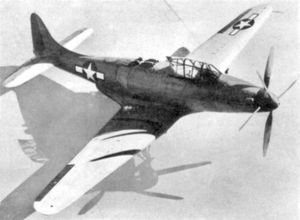PlaneSpottingWorld welcomes all new members! Please gives your ideas at the Terminal.
P-75 Eagle
| P-75 Eagle | |
|---|---|
| Type | Fighter |
| Manufacturer | General Motors Corporation |
| Maiden flight | 17 November 1943 |
| Status | Cancelled 6 October 1944 |
| Number built | 6 |
The General Motors P-75A Eagle was a fighter aircraft for which the General Motors Corporation in September 1942 submitted a proposal to meet a United States Army Air Forces requirement for a fighter possessing an extremely high rate of climb. The proposal was for an aircraft that used the most powerful liquid-cooled engine then available, the Allison V-3420, and components from existing aircraft. At the time, General Motors was busy in several projects towards the war effort, including the mass production of several different aircraft types, including the Grumman Avenger. Some sources claim that the P-75 was the result of a scheme to get General Motors out of being forced to build Boeing B-29s; the P-75 project being a "high-priority" project to help GM avoid the added strain of Superfortress production.
Contents
Design and development
In October 1942, the contract for two prototypes, designated XP-75, was signed with the Fisher Body Division of GM. The design concept was to use the outer wing panels from the P-51 Mustang, the tail assembly from the Douglas A-24 (SBD), and the under carriage from the F4U Corsair in a general layout much as in the P-39 Airacobra with the engine located amidships with the propeller driven through an extension shaft. At an early design stage, however, P-40 Warhawk outer wing panels were substituted for the P-51 panels.
In mid 1943, the need for long-range escort fighter became more urgent than fast climbing interceptors so a decision was made to order six more XP-75 airplanes modified for the long-range role. At this time an order for 2,500 production aircraft was also let, but with the stipulation that if the first P-75A was not satisfactory the complete order might be canceled.
Testing
Powered by a V-3420-19 twenty-four cylinder engine rated at 2,600 hp driving co-axial contra-rotating propellers, the XP-75 flew for the first time on 17 November 1943. The second XP-75 flew shortly thereafter, with all six long-range XP-75s entering the test program by the spring of 1944. The test program brought up a number of deficiencies, including miscalculation of the fighter’s center of mass, engine failure at full rated power, inadequate engine cooling, high aileron forces at high speed, and poor spin characteristics. Re-designs were introduced into the long range XP-75s including a modified tail assembly, new cockpit canopy, and a V-3420-23 engine that corrected most of the problems by the time the first P-75A Eagles entered flight test in September 1944.
Cancellation
By this time, the Army Air Force decided to limit the number of combat aircraft types in production and not enter into large-scale production of new types that might not be available before the war ended. As the P-47D Thunderbolt and P-51D Mustang demonstrated excellent long-range capabilities, the production run of the P-75A Eagle was substantially terminated on 6 October 1944. It was decided to use the five production aircraft completed for experimental work and development of the V-3420 engine. As a result of those events, the P-75A didn’t complete formal performance trials due to termination of the production contract.
Survivors
There was at least one remaining XP-75 as of 1998. It was in an unrestored condition at the National Museum of the United States Air Force, Dayton, Ohio.
Specifications (Long Range XP-75)
General characteristics
- Crew: One
- Length: 40 ft 5 in (12.32 m)
- Wingspan: 49 ft 4 in (15.04 m)
- Height: 15 ft 6 in (4.72 m)
- Wing area: 347 ft² (32.24 m²)
- Empty weight: 11,495 lb (5,214 kg)
- Loaded weight: 13,807 lb (6,263 kg)
- Max takeoff weight: 18,210 lb (8,260 kg)
- Powerplant: 1× Allison V-3420-23 liquid-cooled 24-cylinder double-Vee, 2,885 hp (2,150 kW)
Performance
- Maximum speed: 433 mph (697 km/h) at 20,000 (6,100 m)
- Range: 2,050 mi (3,300 km)
- Service ceiling: 36,400 ft (11,100 m)
- Rate of climb: 4,200 ft/min (21.3 m/s)
- Wing loading: 39.8 lb/ft² (194.3 kg/m²)
- Power/mass: 0.21 hp/lb (0.34 kW/kg)
Armament
- 6x 0.5 in (12.7 mm) wing mounted machine guns
- 4x 0.5 in (12.7 mm) fuselage mounted machine guns
- 2x 500 lb (227 kg) bombs
References
- Green, William. War Planes of the Second World War - Fighters (Vol 4). London: MacDonald, 1961. No ISBN.
- Winchester, Jim. The World's Worst Aircraft: From Pioneering Failures to Multimillion Dollar Disasters. London: Amber Books Ltd., 2005. ISBN 1-904687-34-2.
Related content
Lists relating to aviation | |
|---|---|
| General | Timeline of aviation · Aircraft · Aircraft manufacturers · Aircraft engines · Aircraft engine manufacturers · Airports · Airlines |
| Military | Air forces · Aircraft weapons · Missiles · Unmanned aerial vehicles (UAVs) · Experimental aircraft |
| Notable incidents and accidents | Military aviation · Airliners · General aviation · Famous aviation-related deaths |
| Records | Flight airspeed record · Flight distance record · Flight altitude record · Flight endurance record · Most produced aircraft |

